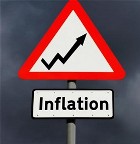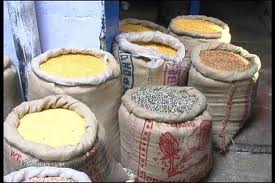Category: Global Economy Sub-category: Indian Economy
Document type: article
-Anurag Agarwal, Research Analyst
 Inflation is substantially beyond India's control in the form of high oil prices and foods priced on international markets. This is not the case. What is beyond control are the price increases on these products. Price increases are caused by the natural law of supply and demand, whereas inflation is an increase in prices overall and not just in some sectors, and is caused by more money flowing into the system.
Inflation is substantially beyond India's control in the form of high oil prices and foods priced on international markets. This is not the case. What is beyond control are the price increases on these products. Price increases are caused by the natural law of supply and demand, whereas inflation is an increase in prices overall and not just in some sectors, and is caused by more money flowing into the system.
Inflation is a measuring index of commodity prices, which is classified as wholesale price index (WPI) and consumer price index (CPI). Almost every other country uses the CPI as a measure of inflation, as this actually measures the increase in price that a consumer will ultimately have to pay for. However, India is the only major country that uses WPI as a measure of inflation. The primary reasons for this may be political as using WPI masks the real picture to a large extent.
Food price inflation is has rose to alarming levels recently at 17.05%. Inflation and price rise has become one of the most pertinent and lingering problem of the country and economy. This issue has gained more importance than the other problems which the country is facing, such as corruption, poverty, public debt etc. This is because inflation directly hurts the common people. Some of the major reasons behind upward surge of inflation and price rise are -
- High input costs: Energy is a major resource input in the economy of a country. The main sources of energy are oil and electricity. Factor costs of these inputs are on steady rise since the natural reserves of oil are depleting every day. Thus, high input cost leads to increase in production cost and higher distribution cost, which leads to increase in prices.
- Inefficient Public Distribution System/ Infrastructural bottlenecks: Whenever, there is a situation of price rise, the general concern is about high food prices and common consumables. Our agricultural commodities face a lot of supply chain bottlenecks from 'farm to dining table', which leads to lot of wastage of food items. This in turns creates a supply shortage for a given time period and hence leads to increase in food prices in a particular season. More than 10% wastage of grains and over 30% of fruits and vegetables are wasted every year. In total food valued at more than Rs.60,000 crore is wasted.
Fragmented supply chains typically including 4-5 intermediaries between the grower and the consumer results in the compounding of margins, which also forms a lacuna in the supply chain and leads to increase in food prices. In case of apple, local distribution cost accounts for around 40% of the apple price.  Impending second green revolution: Today, India's agricultural output sometimes falls short of demand. Green Revolution, howsoever impressive, has thus not succeeded in making India totally and permanently self-sufficient in food. India's population is growing faster than its ability to produce rice and wheat, which is creating supply side constraints.
Impending second green revolution: Today, India's agricultural output sometimes falls short of demand. Green Revolution, howsoever impressive, has thus not succeeded in making India totally and permanently self-sufficient in food. India's population is growing faster than its ability to produce rice and wheat, which is creating supply side constraints.
Adoption of modern agricultural practices and use of technology is inadequate, hampered by ignorance of such practices, high costs and impracticality in the case of small land holdings. Irrigation facilities are inadequate, as revealed by the fact that only 50% of the land is irrigated. To unshackle such supply side constraints, India needs to bring another green revolution.- Government Policies: Interest rates in India is one of the highest in the World due to the current policies adopted by the Reserve bank of India, which increases the cost of capital and in turn increases the manufactured products. Also money supply has increased in the economy. If the Bank stopped increasing the flow of money into the system, prices of petrol and food would still increase, due to the natural law of supply and demand, but consumers would have less to spend on other things. So manufacturers of these other things would be forced to lower their prices in order to remain in business. So the lower prices in some sectors would offset the higher prices in others. This would result in no increase in inflation.
But if government increases the amount of money around, consumers will find themselves with this extra money, and so prices in all sectors will increase - and this is inflation.
Also, Indian rupee is weaker against US dollar mainly due to lobbying by the exporters as a weaker rupee allows exporters to get away with higher profit margins, but this in turn makes imports costlier. Crude comprises of 40% of India's total merchandise imports, hence a weaker rupee will lead to dearer fuel prices and vice versa.
So to sum up, inflation is caused by government when it interferes in the economy by increasing the amount of money in the system.
-









